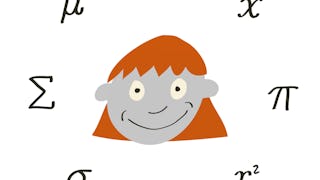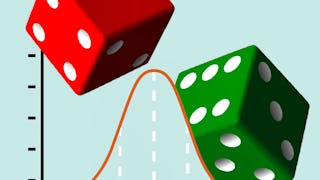Welcome to Engineering Probability and Statistics Part 1. Throughout your time in this course, you will be given opportunities to check your understanding of course material, as well as engage in quizzes to reflect on all the concepts you have explored within each module. By the end of this part 1 course on engineering probability and statistics, you will have a foundational understanding of the fundamentals of statistics, probability, variables, and types of distributions.



Compétences que vous acquerrez
- Catégorie : Data-Driven Decision-Making
- Catégorie : Exploratory Data Analysis
- Catégorie : Correlation Analysis
- Catégorie : Statistical Visualization
- Catégorie : Statistical Modeling
- Catégorie : Descriptive Statistics
- Catégorie : Statistical Analysis
- Catégorie : Probability
- Catégorie : Data Analysis
- Catégorie : Probability & Statistics
- Catégorie : Bayesian Statistics
- Catégorie : Probability Distribution
- Catégorie : Engineering Analysis
Détails à connaître

Ajouter à votre profil LinkedIn
juillet 2025
17 devoirs
Découvrez comment les employés des entreprises prestigieuses maîtrisent des compétences recherchées

Il y a 7 modules dans ce cours
Welcome to your first step into the world of statistics! This module isn't just about numbers—it's about discovering how data can help us make smarter decisions, solve problems, and improve processes. While it may not be apparent, statistics impacts everyday life, and it plays a major role in engineering, from predicting trends to optimizing systems. In this module, you'll explore key ideas such as statistical thinking, understanding variability, and distinguishing between populations and samples. You'll also get hands-on experience with exploratory data analysis (EDA), where you'll learn how to collect, summarize, and visualize data to find meaningful patterns and uncover insights. By the end of this module, you'll have a strong foundation in statistical reasoning, setting you up for success in the rest of the course. So, let's get started and see how statistics can help you make sense of the world around you.
Inclus
4 vidéos28 lectures4 devoirs
Probability is all about understanding uncertainty and making informed decisions. Every day, we encounter situations where the result is unknown—whether it’s predicting the weather or playing a game of chance. In this module, you will learn the basics of probability, including how to define experiments, sample spaces, and events. You will also learn the difference between simple and compound events. A few key rules help us calculate and understand probabilities effectively. You will learn how to apply the complement, addition, and multiplication rules to calculate the likelihood of different events. We will also discuss conditional probability and independence so you can determine if events are related or completely independent. Counting principles such as permutations and combinations will also help you determine the number of possible outcomes in various scenarios. Finally, we’ll introduce Bayes’ Theorem, which is a powerful tool for updating probabilities as new information becomes available. By the end of this module, you will be able to define probability concepts, apply key probability rules, analyze conditional probability, use counting principles, and apply Bayes' Theorem to make data-driven decisions.
Inclus
2 vidéos16 lectures2 devoirs
In this module, we’ll cover some of the most fundamental concepts in statistics: random variables and probability distributions. These concepts enable us to mathematically model previously discussed probability-based scenarios. Specifically, you’ll learn how random variables act like the link between probability theory and analytics. We’ll also take a look at the difference between discrete and continuous random variables and examine some types of probability distributions.
Inclus
6 lectures2 devoirs
In this module, we’ll explore some important discrete probability distributions that help us model real-world randomness. These distributions provide a structured way to analyze uncertainty in everyday scenarios, from predicting defective products in manufacturing to estimating customer arrivals at a service center. We’ll cover the Binomial, Negative Binomial, Hypergeometric, and Poisson distributions. You'll learn how to choose the right distribution for the right scenario, model complex situations, and understand the fascinating Poisson process, which governs time-dependent events such as traffic flow and server requests. By the end of this module, you'll be equipped with the skills to analyze, model, and interpret discrete probability distributions, turning theoretical concepts into practical insights!
Inclus
4 vidéos14 lectures2 devoirs
In this module, we’ll learn about another type of random variable, continuous random variables. Based on this different type of random variable, we will be defining new types of probability distributions. We will explore the types of continuous random variables, probability distribution functions for continuous random variables, and then the uniform, normal, and lognormal distributions. By the end of this module, you'll be equipped with the skills to analyze, model, and interpret continuous variables and probability distributions, turning theoretical concepts into practical insights.
Inclus
1 vidéo14 lectures2 devoirs
In this module, we dive deeper into continuous probability distributions. You will explore the connections between the exponential and Poisson distributions in modeling event timing and how the gamma and Weibull distributions help analyze system reliability and failure rates. You'll also be introduced to the beta distribution, a flexible tool for modeling uncertainty in bounded processes. By the end of this module, you’ll be able to select and apply the right distribution for real-world problems, interpret key parameters, and understand their practical implications.
Inclus
3 vidéos14 lectures3 devoirs
In this module, we explore joint probability distributions—a powerful framework for analyzing how multiple random variables interact and relate to one another. You will learn how to model and interpret relationships between two random variables, whether they are continuous or discrete. We will begin by establishing the foundational concepts of joint probability distributions and examine how they capture the simultaneous behavior of random variables. You will learn to extract meaningful insights through marginal and conditional distributions, allowing you to understand both the individual behavior of variables and how they behave when other variables are fixed. Finally, we will investigate the critical concepts of covariance and correlation, developing your ability to quantify dependency relationships between random variables and determine whether they move together, in opposition, or independently. By the end of this module, you will have the analytical tools necessary to examine complex probabilistic systems involving two interrelated variables—an essential skill for advanced statistical modeling and data analysis.
Inclus
1 vidéo16 lectures2 devoirs
Obtenez un certificat professionnel
Ajoutez ce titre à votre profil LinkedIn, à votre curriculum vitae ou à votre CV. Partagez-le sur les médias sociaux et dans votre évaluation des performances.
Instructeur

Offert par
En savoir plus sur Probability and Statistics
 Statut : Essai gratuit
Statut : Essai gratuitUniversity of Amsterdam
 Statut : Essai gratuit
Statut : Essai gratuitJohns Hopkins University
 Statut : Essai gratuit
Statut : Essai gratuitUniversity of Colorado Boulder
 Statut : Prévisualisation
Statut : PrévisualisationUniversity of Zurich
Pour quelles raisons les étudiants sur Coursera nous choisissent-ils pour leur carrière ?





Ouvrez de nouvelles portes avec Coursera Plus
Accès illimité à 10,000+ cours de niveau international, projets pratiques et programmes de certification prêts à l'emploi - tous inclus dans votre abonnement.
Faites progresser votre carrière avec un diplôme en ligne
Obtenez un diplôme auprès d’universités de renommée mondiale - 100 % en ligne
Rejoignez plus de 3 400 entreprises mondiales qui ont choisi Coursera pour les affaires
Améliorez les compétences de vos employés pour exceller dans l’économie numérique
Foire Aux Questions
To access the course materials, assignments and to earn a Certificate, you will need to purchase the Certificate experience when you enroll in a course. You can try a Free Trial instead, or apply for Financial Aid. The course may offer 'Full Course, No Certificate' instead. This option lets you see all course materials, submit required assessments, and get a final grade. This also means that you will not be able to purchase a Certificate experience.
When you purchase a Certificate you get access to all course materials, including graded assignments. Upon completing the course, your electronic Certificate will be added to your Accomplishments page - from there, you can print your Certificate or add it to your LinkedIn profile.
You will be eligible for a full refund until two weeks after your payment date, or (for courses that have just launched) until two weeks after the first session of the course begins, whichever is later. You cannot receive a refund once you’ve earned a Course Certificate, even if you complete the course within the two-week refund period. See our full refund policy.
Plus de questions
Aide financière disponible,


